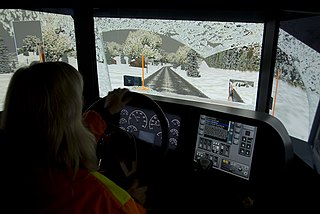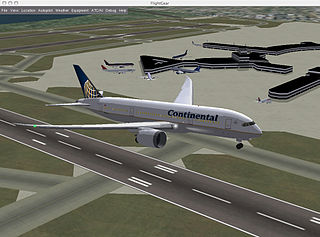Related Research Articles

A simulation is an imitative representation of a process or system that could exist in the real world. In this broad sense, simulation can often be used interchangeably with model. Sometimes a clear distinction between the two terms is made, in which simulations require the use of models; the model represents the key characteristics or behaviors of the selected system or process, whereas the simulation represents the evolution of the model over time. Another way to distinguish between the terms is to define simulation as experimentation with the help of a model. This definition includes time-independent simulations. Often, computers are used to execute the simulation.

A flight simulator is a device that artificially re-creates aircraft flight and the environment in which it flies, for pilot training, design, or other purposes. It includes replicating the equations that govern how aircraft fly, how they react to applications of flight controls, the effects of other aircraft systems, and how the aircraft reacts to external factors such as air density, turbulence, wind shear, cloud, precipitation, etc. Flight simulation is used for a variety of reasons, including flight training, the design and development of the aircraft itself, and research into aircraft characteristics and control handling qualities.

Microsoft Flight Simulator is a series of flight simulator programs for MS-DOS, Classic Mac OS and Microsoft Windows operating systems. It was an early product in the Microsoft application portfolio and differed significantly from Microsoft's other software, which was largely business-oriented. As of November 2022, Microsoft Flight Simulator is the longest-running software product line for Microsoft, predating Windows by three years. Microsoft Flight Simulator is one of the longest-running PC video game series of all time.
X-Plane is a flight simulation software initially launched by Laminar Research in 1995. Commercial desktop versions are sold for macOS, Windows, and Linux. In addition, Laminar Research also distributes FAA-certified versions for professional use. A mobile version has been available for Android, iOS, and webOS since 2009 as well.
In video games, a clan, community, guild or faction is an organized group of video game players that regularly play together in one or more multiplayer games. Many clans take part in gaming competitions, but some clans are just small gaming squads consisting of friends. These squads range from groups of a few friends to four-thousand plus person organizations, with a broad range of structures, goals and members. The lifespan of a clan also varies considerably, from a few weeks to over a decade. Numerous clans exist for nearly every online game available today, notably in first-person shooters (FPS), massively multiplayer games (MMO), role-playing video games (RPG), and strategy games. There are also meta-groups that span a wide variety of games. Some clans formed by groups of players have grown into multi-million dollar professional esports teams.

A simulation cockpit, simpit or sim rig is an environment designed to replicate a vehicle cockpit. Although many pits commonly designed around an aircraft cockpit, the term is equally valid for train, spacecraft or car projects.

Virtual Air Traffic Simulation Network (VATSIM) is a nonprofit organization that operates an online flight-simulation network noted for its active membership and realism. Users are able to fly aircraft as a pilot, or direct traffic as an air traffic controller in what has been described as a close approximation of real-life aviation procedures.
Combat flight simulators are vehicle simulation games, amateur flight simulation computer programs used to simulate military aircraft and their operations. These are distinct from dedicated flight simulators used for professional pilot and military flight training which consist of realistic physical recreations of the actual aircraft cockpit, often with a full-motion platform.

A motion simulator or motion platform is a mechanism that creates the feelings of being in a real motion environment. In a simulator, the movement is synchronised with a visual display of the outside world (OTW) scene. Motion platforms can provide movement in all of the six degrees of freedom (DOF) that can be experienced by an object that is free to move, such as an aircraft or spacecraft:. These are the three rotational degrees of freedom and three translational or linear degrees of freedom.
Microsoft Flight Simulator began as a set of articles on computer graphics, written by Bruce Artwick throughout 1976, about flight simulation using 3-D graphics. When the editor of the magazine told Artwick that subscribers were interested in purchasing such a program, Artwick founded Sublogic Corporation to commercialize his ideas. At first the new company sold flight simulators through mail order, but that changed in January 1979 with the release of Flight Simulator (FS) for the Apple II. They soon followed this up with versions for other systems and from there it evolved into a long-running series of computer flight simulators.

Microsoft Flight Simulator X is a 2006 flight simulation video game originally developed by Aces Game Studio and published by Microsoft Game Studios for Microsoft Windows. It is the sequel to Microsoft Flight Simulator 2004 and the tenth installment of the Microsoft Flight Simulator series, which was first released in 1982. It is built on an upgraded graphics rendering engine, showcasing DirectX 10 features in Windows Vista and was marketed by Microsoft as the most important technological milestone in the series at the time. FSX is the first version in the series to be released on DVD media.
Bruce Arthur Artwick is an American software engineer. He is the creator of the first consumer flight simulator software. He founded Sublogic after graduating from the University of Illinois at Urbana–Champaign in 1977, and released the first version of Flight Simulator for the Apple II in 1979. His original Apple II software was purchased by Microsoft in 1982 and became Microsoft Flight Simulator 1.0.
Vehicle simulation games are a genre of video games which attempt to provide the player with a realistic interpretation of operating various kinds of vehicles. This includes automobiles, aircraft, watercraft, spacecraft, military vehicles, and a variety of other vehicles. The main challenge is to master driving and steering the vehicle from the perspective of the pilot or driver, with most games adding another challenge such as racing or fighting rival vehicles. Games are often divided based on realism, with some games including more realistic physics and challenges such as fuel management.

FlightSim.Com is a flight simulation review and resource website that focuses heavily on Microsoft Flight Simulator. It is one of the main flight simulation websites along with Avsim.com and provides users access to information and addons for the flight simulator series of video games.

AVSIM is a nonprofit flight simulation social networking service that focuses on Microsoft Flight Simulator, Prepar3D, and X-Plane. It features a community forum, file library, and product reviews. The website is maintained by a group of volunteers. Bandwidth and equipment is paid for by donations and advertising. It is one of the world's largest flight simulation websites and provides users access to information and add-ons for the flight simulator series of games. On May 12, 2009, the website was attacked by a hacker which resulted in a catastrophic loss of data. AVSIM was able to fully recover from the hack with the help of IT support from around the world.

A Virtual Military Organization (VMO) is a dedicated hobby organization that uses simulation to model the operations of a military. Virtual Military Organizations (VMOs) generally have a presence on the internet, similar to real military organizations. Most VMOs simulate military operations to varying degrees. A newer variant of Virtual Military is the MilSim unit. MilSim units differ from Virtual Military by placing emphasis on the simulation of military tactics in their chosen gaming platform, whereas traditionally, VMOs have placed emphasis on simulating the bigger picture, including a full military career path, logistics systems, coordinated movement of equipment around the world, and prolonged military operations. Although VMOs may appear to be a type of gaming clan, a key difference is that a gaming clan's primary purpose is to be an "organized group of players that regularly play together." VMOs are essentially role-playing environments within which an individual can immerse themselves. Realism groups are semantically similar; however, their primary focus is usually on following real-life procedures as much as possible. Therefore, tactical realism and MilSim are almost synonymous in the gaming world. A Google search for 'Virtual Military' reveals quite a few VMOs that go to varying degrees of depth to pursue their goal.

A flight simulation video game refers to the simulation of various aspects of flight or the flight environment for purposes other than flight training or aircraft development. A significant community of simulation enthusiasts is supported by several commercial software packages, as well as commercial and homebuilt hardware. Open-source software that is used by the aerospace industry like FlightGear, whose flight dynamics engine (JSBSim) is used in a 2015 NASA benchmark to judge new simulation code to space industry standards, is also available for private use. A popular type of flight simulators video games are combat flight simulators, which simulate combat air operations from the pilot and crew's point of view. Combat flight simulation titles are more numerous than civilian flight simulators due to variety of subject matter available and market demand.

International Virtual Aviation Organisation VZW (IVAO) is a non-profit association which operates a free-of-charge online flight-simulation network. Following free registration users can connect to the IVAO Network (IVAN) either as a virtual air traffic controller or as a virtual pilot and engage and interact with each other in a massively multiplayer environment utilising real-world aviation procedures, phraseology and techniques.
A flight simulator is a device that artificially re-creates aircraft flight and various aspects of the flight environment. Those not for flight training or aircraft development may be referred to as amateur flight simulators.

Microsoft Flight Simulator is a flight simulation video game developed by Asobo Studio and published by Xbox Game Studios. It is an entry in the Microsoft Flight Simulator series which began in 1982, and was preceded by Microsoft Flight Simulator X in 2006. The game is a return of the series after 14 years, with development beginning six years prior to its release. It was released on August 18, 2020, for Windows, with a virtual reality (VR) version released in December of the same year as part of the free Sim 2 update. Microsoft Flight Simulator is the first game in the series to see a VR and console release, with it being released on the Xbox Series X and Series S on July 27, 2021.
References
- 1 2 Radcliffe, Doug; Andy Mahood (2003). Microsoft Flight Simulator 2004: A Century of Flight (Official Strategy Guide). John Wiley & Sons. pp. 169, 173, 189, 198. ISBN 978-0-7821-4237-2.
- 1 2 3 4 Mark, Robert (1999). Professional Pilot Career Guide . McGraw-Hill Professional. pp. 329–330. ISBN 978-0-07-134691-7.
Virtual Airline.
- 1 2 3 4 5 Galvin, Nick (2006-06-06). "Cockpit capers". The Sydney Morning Herald. Retrieved 2009-01-14.
- 1 2 3 4 5 6 7 8 9 Van West, Jeff; Kevin Lane-Cummings (2007). Microsoft Flight Simulator X for Pilots. John Wiley and Sons. pp. 672–685. ISBN 978-0-7645-8822-8.
- ↑ Regis, Ed (2009-01-01). "Welcome to Cyberairspace". Air & Space Magazine . Retrieved 2011-03-28.
- 1 2 Case, Loyd (2000). The Complete Idiot's Guide to Playing Games Online. Que. p. 314. ISBN 978-0-7897-2223-2.
- ↑ Orr, Josh (2006-05-02). "Teen earns wings for his first solo flight". The Sarasota Herald Tribune. Archived from the original on January 11, 2009. Retrieved 2008-07-14. Alt URL
- ↑ Murphy, Kate (March 22, 2014). "The Pilots in the Basement". The New York Times (published March 23, 2014). p. SR5.
- ↑ Wade, Alex (2008-09-11). "Space pilot: an introduction to amateur flight simulation". Social Semiotics. 18 (3): 277–288. doi:10.1080/10350330802217055. S2CID 143606973.
- 1 2 Maharg, Paul (2007). Transforming legal education: learning and teaching the law in the early twenty-first century. Ashgate Publishing, Ltd. p. 346. ISBN 978-0-7546-4970-0.
- ↑ "VATSIM - Virtual Air Traffic Simulation Network" (Press release). MITRE Corporation. 2008-01-12. Archived from the original on 2008-03-08. Retrieved 2008-04-14.
- 1 2 Finn, Gary (2011-08-21). "Simulation de vol sur Internet : Aux commandes virtuelles". El Moudjahid (in French). Algeria.
- ↑ Lichty, Tom (1996). The official America Online for Windows 3.1 tour guide . Ventana. pp. 334. ISBN 978-1-56604-373-1.
- ↑ Lichty, Tom (1995). The Official America Online for Macintosh Tour Guide. Research Triangle Park, NC: Ventana. p. 333. ISBN 978-1-56604-383-0.
- ↑ AP (1997-08-24). "Great beyond has comforts of home software lets desk-bound pilots fly across the globe, elaborately". Chicago Tribune. Retrieved 2011-09-13.
- ↑ Merry, John A. (1999). 300 best aviation web sites: and 100 more worth bookmarking (3 ed.). McGraw-Hill. p. 340. ISBN 978-0-07-134835-5.
With the virtual airline (VA) industry rapidly evolving into a complex maze of airlines...
- ↑ Tibbits, George (1997-08-20). "New Flight Simulator feeds habit flying game 'like an addiction'". The St. Louis Post-Dispatch. Retrieved 2008-07-15.
- ↑ Alan Stuart (28 October 2002). "Flight Sim: The Expert". The Buzz (Interview: transcript). Interviewed by Aedy Richard. ABC Radio National. Retrieved 14 January 2011.
- ↑ Husted, Bill (2006-05-05). "Companies see rise in average computer gamers' age". The Atlanta Journal-Constitution. Retrieved 2008-07-14.
That question came up on the virtual airline, and there are a lot of young folks," Kendrix said. "But almost as many in their 20s, 30s, 40s, 50s, etc.
- ↑ "VATSIM Special Operations Policy Document" (PDF). Archived from the original (PDF) on 2008-05-11. Retrieved 2008-03-26.
- ↑ Williams, Bruce (2007). Microsoft Flight Simulator as a Training Aid: A Guide for Pilots. Aviation Supplies & Academics. ISBN 978-1-56027-670-8.
- 1 2 Tompkins, Joshua (2003-07-23). "Air Osama". Salon.com . p. 4. Archived from the original on 2011-07-16. Retrieved 2008-06-25.
Some began to organize virtual airlines, for which other users... volunteer to fly designated... often in aircraft bearing the imaginary carrier's livery, in hopes of earning promotions and new assignments.
- ↑ Ligerakis, Maria (7 May 2004). "Jetstar in naming stoush". B&T. Archived from the original on 25 December 2007. Retrieved 2008-03-26.
- ↑ Wade, Alex (2008-08-18). "Space pilot: an introduction to amateur flight simulation". Social Semiotics . 18 (3): 277–288. doi:10.1080/10350330802217055. S2CID 143606973.
...Qantas Australian airline were sued by a virtual airline for using their name...
- ↑ Gardham, Duncan (2005-08-17). "Two bomb suspects shared a flat". The Telegraph. Retrieved 2008-10-27.
- 1 2 Staff writers (2005-07-25). "Bomber's link to 'pilot' probed". BBC News. Retrieved 2008-10-27.
- ↑ Staff writers (2005-07-27). "Flight website denies bomber link". BBC News. Retrieved 2008-10-27.